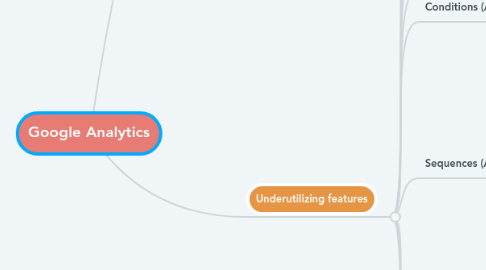
1. Segments
1.1. “Using segments in GA is pretty much a must have — it’s by far the easiest and most effective way to remarket without extremely sophisticated tools most of us don’t have access to. At the very least, you should have segments for each level of intent — ranging from ‘viewed blog’ (low intent) to ‘reached the credit card step’ (high intent). You can then set higher bids on Google Display Network or Search based on how high the intent is.” (Ryan Farley, co-founder and head of growth at LawnStarter)
2. Underutilizing features
2.1. Channel Groupings
2.2. Campaign Tracking (Strategy)
2.3. Custom Alerts
2.3.1. Custom Alerts helps you automatically get notified of any notable trends in your data.
2.4. Annotations
2.5. Reporting Automation
2.6. Conditions (Advanced Segments)
2.7. Sequences (Advanced Segments)
2.7.1. With Sequences, you can start to measure which of your users made specific behaviors in a certain order.
2.7.2. For example, with Sequences at your fingertips, you can create a segment of users who viewed a product detail page, then immediately clicked on the add-to-cart button. Then compare that segment with users who viewed a product detail page, interacted with the images of the product, and only then clicked on the add-to-cart button. Comparing the results of those two groups can help you answer a question like “are the product image thumbnails that important… are they leading to a sale?” and so on.
2.7.3. Knowing which type of page a user was on when they took a specific action allows us to make inferences about their intent.
2.7.4. This is particularly important because the creation of a segment in GA not only allows us to understand our users and their behavior based upon the actions they take, but we can create Audiences for remarketing from those very same segments in just a few clicks.
2.8. Demographics
2.9. Cost Data Reports
2.9.1. Importing cost and click data from non-Google advertising initiatives lets you explore in greater detail the Return on Investment of your campaigns.
2.10. Search Terms and Queries
2.10.1. The search terms will tell you what stage of awareness people are at (unaware, pain aware, solution aware, product aware or most aware), their pains, hesitations and concerns.
2.10.2. If there are any rising trends for which you don’t have pages or content, you know that you should probably invest the time in creating them.
2.11. Gettings Outside of Google Analytics
2.11.1. You can port your data to Excel and R, as many do for analysis–but a greater step, if you want to have full access to your raw data, is to pull your data to a BigQuery database. There, you can do things like pull your data into different tools, combine pre- and post-purchase data, and build out stunning models and visualizations.
2.11.1.1. Path Analysis in Google Analytics 360
